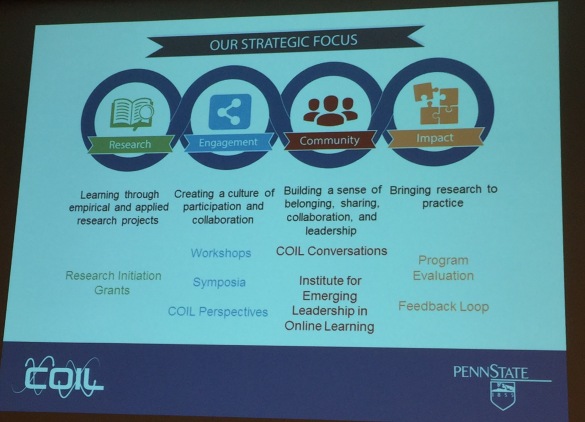COIL is a cross-discipline research and development center directed toward transforming learning through online innovations. Programs, services and lessons learned will be shared.
In 2012, Penn State created the Center for Online Innovation in Learning (COIL) with the mission to engage the University’s extensive research enterprise to improve online learning at and beyond Penn State. Building upon over 100 years in distance education and over 15 years of leadership in online education via Penn State’s World Campus initiative, COIL is a cross-discipline research and development center sponsored and supported by colleges and departments spanning the University. The core mission of COIL was intended to guide the transformation of teaching and learning processes by supporting researchers who want to investigate, invent, and implement technologically enhanced online innovations.
Over the past three years, COIL has developed and refined a model to engage diverse constituent groups including faculty, staff and students in conducting first-hand research around a variety of online innovations. Built around COIL’s Research Initiation Grant (RIG) program, this model has led to significant achievements in improving learning at Penn State and beyond and has contributed to the development and nurturing of a community-driven culture of research and development. Additional programs aimed to generate dialog and a culture of innovation will be shared.
This session will highlight the COIL initiatives, services, and programs designed to support and improve the success of learners via online innovations. The COIL Research Initiation Grant program including the process, products, outcomes, and related insights will be shared. It will also include discussion and activities intended to contextualize the COIL model for participants and to identify potential for cross-institution collaborations.
Notes:
- Goal: Lead and create a conversation and culture of innovation at the university.
- Innovative ideas sprouting up around the university, but they didn’t really continue beyond one semester. There wasn’t the support or facilitating the ideas to scale across the university.
- What hasn’t been tried yet?
- What new or emerging technologies are available?
- Mission: “The Center for Online Innovation in Learning (COIL) is a research and development center created to build and sustain a culture of innovation, collaboration, and invention focused on improving teaching and learning. COIL serves faculty, staff and students interested in the transformation of the educational paradigm.”
- Assist in solving problems (BYOP) and collaborate to align resources across the university.
- Setting the Stage = Community > Engagement > Impact > Research
- Challenges = Determining a Focus, Need to Show Impact, Being Visible, Overlapping goals and missions/situated in a large diverse, distributed institution (aka “turf”) > try to work with these other areas as partners. Moving outside the echo chamber and competing interests. Proof of impact and evaluation.

